Back to page 1
The Essentials
So we’ve established that Citi Field is extremely aesthetically pleasing (except for its neighborhood) and well designed. Would it surprise you to learn that the fan amenities are outstanding, too? I didn’t think so.
This is a supremely fun ballpark. It’s not a cheap place to attend a game, but it’s a lot more affordable than new Yankee Stadium.
Parking will run you $18 in the lots that surround the park — and parking is a lot easier than during the last two years of Shea, because the construction wiped out so many spaces. There are cheaper lots not operated by the team nearby, especially just to the north and to the south near the tennis center. I wouldn’t even dream of parking in the midst of the ramshackle auto-repair places across 126th Street, though.
As you’d expect, ticket prices encompass a very wide range — but the high end isn’t anywhere near Yankee Stadium’s top price tags.
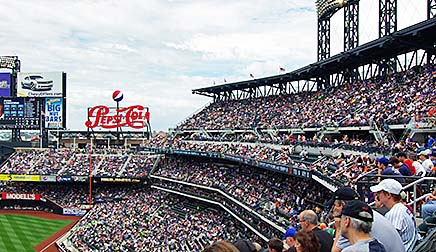 |
Yes, tickets are pricey, but it’s difficult to describe for you the cost. That’s because the Mets have five different categories for their home games. For instance, Baseline Boxes, which are likely to be the best seats you could purchase on a single-game basis, cost only $45 for “Value” games, but are $60, $75, $90 and $105 for (respectively) Bronze, Silver, Gold and Platinum games. So the opponent largely drives how much you pay for your seats.
And if you think five categories of games is a lot, try this: the Mets have 38 different kinds of seat categories. Wow! Let’s look at a few representative seating selections, discussing them in terms of their prices in ranges, from the low-end “Value” games to the high-end “Platinum” contests. Therefore, Baseline Boxes range from $45 to $105.
Those funky Bridge Terrace seats (next to the walkway bridge in right field) range from $27 to $63. Next door in the Big Apple seats, you’ll pay $21-$49.
Moving up to the Excelsior Level, most of the seats in the popular Pepsi Porch in right field and the Left Field Landing range from $24 to $56. Up in the Promenade Level, the boxes (which are the front part of the level below the concourse, but beyond the infield — see the photo on the left side below) cost $21-$49, reserved seats in the infield in the uppermost deck are $15-$35 and the reserved seats beyond the infield will run you $11-$27. Finally a price range I can live with.
If these ticket prices sound more reasonable than at new Yankee Stadium, then, well, you’ve been paying attention.
Game programs, by the way, cost $5, and the souvenir prices are about what you would expect: most adult T-shirts are $28, but they run as high as $42; adjustable caps are $25 and fitted ones are $32; lapel pins run $8-$10.
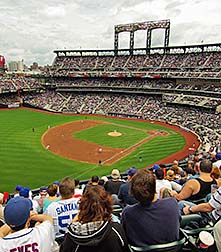 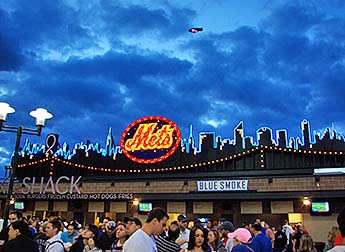 |
You probably think I’m obsessed with comparing facets of the two new New York parks, but indulge me while I compare a few prices:
| Yankee Stadium | Citi Field | |
|---|---|---|
| Parking | $19 | $18 |
| Programs | $10 | $5 |
| Media guides | $20 | $20 |
| Team yearbooks | $25 | $12 |
| Nathan’s beef hotdog | $5 | $5.75 |
| Regular cup of beer | $6 | $5 |
So you can get a Nathan’s dog cheaper in the Bronx, but pretty much everything else is higher.
But what about the food choices at Citi Field? In a word, they are phenomenal.
There is a point of sale for concessions for every 150 seats (a 41% increase over Shea Stadium), so you’re never far from one — and believe me, you’re never more than a few feet from a stand with Nathan’s dogs and fries, because they’re everywhere. In fact, there are two in the aforementioned food court on the top level behind home plate.
Prehaps the most comprehensive clustering of food stands is on the field level concourse in center and right field. The Met’s refer to this area as the Taste of the City, because you’ll find some of NYC’s favorite foods. Here are Blue Smoke’s ribs and the Shake Shack, both below the faux skyline made famous at Shea (above right — note the blimp). You’ll also find El Verano Taqueria’s Mexican dishes, Big Apple Brews and my favorite, the seafood at Catch of the Day.
My favorite clustering of food sellers, though, is a good bit harder to find. It’s called the World’s Fare Market, which of course is a play on words since the 1964 Worlds Fair was held about a mile south of the ballpark. This “market” is on the field level, all the way back in the right-field corner, and I worry that it doesn’t receive nearly the business that it deserves because fans aren’t going to run across it. Anyway, if you do locate it, you’ll find the following: the World’s Fare Grill, with specialty sandwiches ($12.50) as well as salads and chili; Mama’s of Corona, with wonderful Italian specialties like turkey and mozzarella ($9.75), antipasto salad ($9.75) and gorgeous — and delicious — cannoli ($3.00, below left); and Daruma of Tokyo, with a colorful array of sushi (below center), including their specialty, the “shrimp dog” ($8.75, below right).
When I return to Citi Field, I am heading straight to the World’s Fare Market!
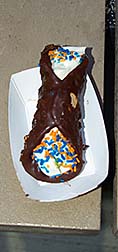 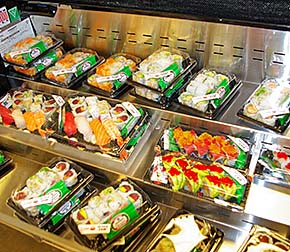 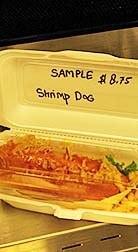 |
But eating isn’t the only fun thing you can do at this park. In fact, like its ballpark cousin down in Coney Island, this facility is designed to be enjoyed, rather than revered. Unlike in the Bronx.
If the Jackie Robinson Rotunda is the best feature at this ballpark, ranking second would have to be the 2K Sports Fan Fest area in center field. Once you arrive here, you may have a challenge pulling your kids away so you can go watch the ballgame!
As you can see below, here’s where you’ll find a dunk tank, a miniature playing field complete with video scoreboard (very cool) and a hut with video games in HD. You’ll also find batting cages and food kids love. Even Mr. Met, the least flashy of all sports mascots, takes up residence there before games to sign autographs.
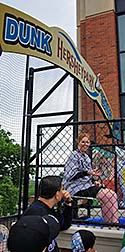   |
If you’re successful prying your kids away from all of the fun in center field, you’ll really enjoy yourself while watching the game. Not only are the seats wider and the legroom more spacious at Shea, the information you’ll get from the scoreboard is astonishing.
That’s because there’s not one but two high-resolution video screens to tell you everything about the batter and the game.
 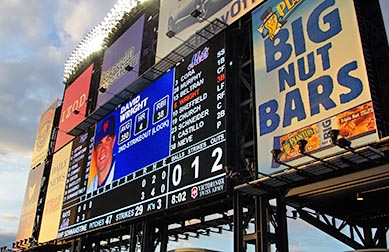 |
Last but not least, an old favorite still makes an appearance at Met games — well, an updated version of an old favorite. As we mentioned, the home-run apple that appeared in the outfield at Shea is now near the Bullpen Gate. Now when a Met hits one out at Citi Field, a new, shinier apple appears out of the batter’s eye in center field — to the delight of the thousands in attendance.
  |
While it’s true that features that emphasize the Mets’ past, like the apple, aren’t plentiful enough at Citi Field, the team is trying to address that. I look forward to visiting in the future to see how that is coming along … and to eat some more of the food in the World’s Fare Market!
Summary
So we’ve learned that Citi Field has a lot going for it … but its neighborhood isn’t one of them.
Our ballpark reviews assess four key areas, and while the Mets’ new home doesn’t hit a home run in “setting” (although it has nice highway and mass-transit access), it couldn’t grade much higher in exterior, interior design and fan amenities.
 |
In fact, the opening of Citi Field moves the Mets from the bottom of the heap (ballpark-wise) in the NL East to the top, passing two other nice, new facilities (Nationals Park and Citizens Bank Park). That’s my assessment, anyway.
How does it rank among the newer big-league ballyards? Very well. There are now 21 MLB stadiums that have opened since the dawn of the New Age Era of ballparks, which I set at roughly 1990. Truly, I think it’s one of the four best of this era. It’s not the perfect-on-all-levels park in Pittsburgh, nor does it have the fabulous setting and view of AT&T Park or Coors Field, but Citi Field outranks all the rest.
And that’s saying a lot. Of course, if you’re a customer of one of those, um, auto repair facilities across the street, maybe they’ll throw in a pair of tickets to see the Mets play! Or maybe the best you could hope for is that they won’t swipe your wheels and leave your car up on blocks.